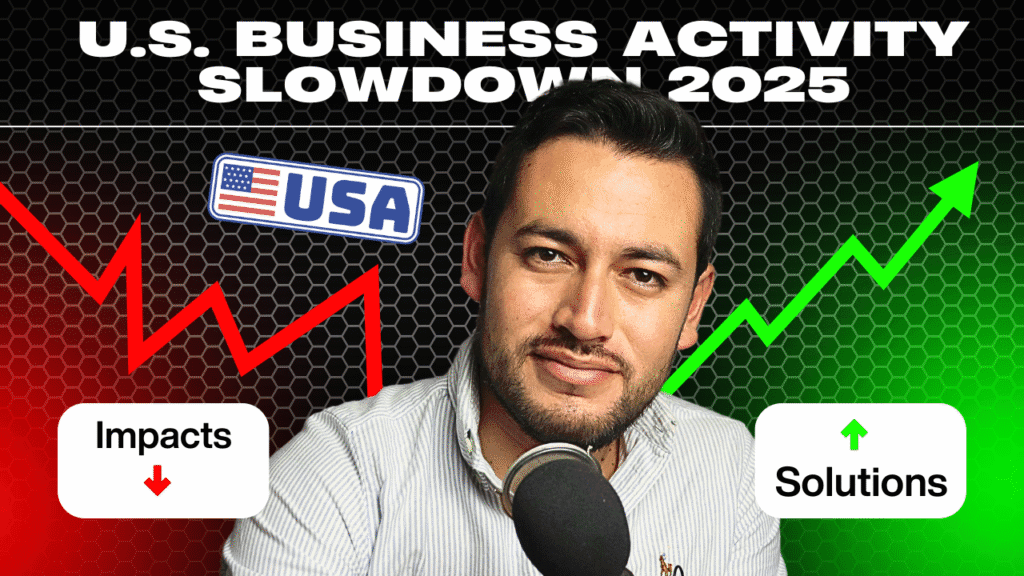The U.S. business activity slowdown 2025 is becoming a major topic of discussion among economists, policymakers, and business owners. Both the manufacturing and services sectors are reporting weaker growth, while input costs continue to rise due to tariffs, inflation, and global supply chain disruptions. Many companies are struggling to pass these rising costs on to customers due to softer demand, which is putting pressure on profit margins.
In this article, we explore the key drivers behind the slowdown, the impacts on small and medium-sized businesses, and actionable strategies for navigating economic challenges in 2025.
Understanding the U.S. Business Activity Slowdown 2025
The U.S. business activity slowdown 2025 is evident in multiple economic indicators. According to recent data:
- S&P Global U.S. Composite PMI Output Index: Fell from 54.6 in August to 53.6 in September, signaling a moderation in growth.
- Manufacturing & Services Sectors: Both sectors show slower expansion with increasing input costs.
- Business Sentiment: Companies report challenges passing higher costs to clients due to weaker demand.
This slowdown reflects not only domestic economic pressures but also global economic factors such as trade disruptions, rising commodity prices, and ongoing geopolitical uncertainties.

Rising Input Costs: Tariffs, Inflation, and Supply Chain Issues : U.S. Business Activity Slowdown 2025
Rising input costs are one of the most pressing challenges for U.S. businesses in 2025. Factors include:
- Tariffs & Trade Policies: Higher tariffs on imports, particularly raw materials and intermediate goods, are raising production costs.
- Inflation: Consumer prices continue to rise, keeping production costs elevated.
- Labor & Supply Chain Costs: Shortages in skilled labor and higher transportation costs are adding additional pressures.
Businesses face a delicate balance: raising prices too much can reduce demand, while absorbing the costs cuts into profitability. This is especially true for small and medium-sized businesses operating on tight margins.
Inflation & Its Impact on Businesses : U.S. Business Activity Slowdown 2025
Inflation remains above the Federal Reserve’s target of 2%, affecting both consumers and businesses:
- Consumer Behavior: Higher prices reduce spending, leading to weaker demand for products and services.
- Profit Margins: Companies are squeezed as input costs rise faster than sales prices.
- Investment Plans: Businesses may delay expansions or hiring due to economic uncertainty.
The U.S. business activity slowdown 2025 is closely linked to inflationary pressures, as higher operational costs make it difficult for businesses to maintain profitability while keeping prices competitive.
Federal Reserve Actions & Interest Rate Implications
In 2025, the Federal Reserve reduced interest rates by 25 basis points, bringing them to a 4.00%-4.25% range. The rate cut is intended to:
- Stimulate economic activity
- Encourage borrowing for investment and expansion
- Ease financial pressures on businesses and consumers
However, lower interest rates alone cannot offset rising input costs. Businesses need strategic planning to maintain cash flow, manage expenses, and protect profitability during the slowdown.
Small Business Challenges Amid the U.S. Business Activity Slowdown 2025
Small businesses face unique challenges in the U.S. business activity slowdown 2025:
- Cash Flow Pressure: Delays in client payments and higher operational costs can strain liquidity.
- Pricing Difficulties: Limited ability to increase prices without losing customers.
- Operational Inefficiencies: Manual processes and poor financial planning can amplify the effects of economic slowdown.
Businesses that proactively monitor cash flow, reduce unnecessary costs, and optimize operations are better positioned to weather the slowdown.

Strategies for Businesses to Navigate the Slowdown : U.S. Business Activity Slowdown 2025
1. Monitor and Optimize Cash Flow
- Track all expenses and payments regularly
- Implement clear invoicing practices for timely payments
- Use digital tools to streamline payment collection
2. Reduce Operational Costs
- Negotiate with suppliers for better rates
- Automate repetitive tasks to save time and labor costs
- Consider flexible work arrangements to reduce overhead
3. Diversify Revenue Streams
- Expand into complementary products or services
- Explore new market segments to reduce dependency on a single income source
4. Strengthen Customer Relationships
- Offer value-added services to retain clients
- Communicate transparently about pricing changes or delays
- Implement loyalty programs or incentives
5. Leverage Technology
- Adopt digital invoicing, accounting, and reporting systems
- Use cloud-based tools for better scalability and efficiency
These strategies help businesses stay resilient and maintain profitability even when facing rising input costs and softer demand.
Case Study: U.S. Business Activity Slowdown 2025
A medium-sized U.S. manufacturer experienced:
- Rising raw material costs by 12% year-over-year
- Moderate demand, making it difficult to pass costs to customers
- Implementation of cost-control measures reduced overhead by 8%
This proactive approach helped the company maintain operations without resorting to layoffs or significant price hikes, showing how planning and technology can mitigate the impact of the U.S. business activity slowdown 2025.
Future Outlook
While the slowdown is concerning, there are potential bright spots:
- Technology & E-commerce: Continue growing despite traditional sector slowdowns
- Interest Rate Cuts: May stimulate borrowing and investment in later 2025
- Consumer Adaptation: People adjust spending patterns and seek cost-effective alternatives
Businesses that remain agile, use data-driven strategies, and monitor economic trends can adapt and thrive despite challenging conditions.
FAQs (Frequently Asked Questions)
Q1: What is driving the U.S. business activity slowdown 2025?
- Rising input costs, inflation, softening demand, and supply chain disruptions are the main drivers.
Q2: How does inflation affect small businesses?
- Higher prices increase operational costs, reduce consumer spending, and compress profit margins.
Q3: What can small businesses do to maintain profitability?
- Optimize cash flow, diversify revenue streams, reduce operational costs, strengthen customer relationships, and leverage technology.
Q4: What is the role of the Federal Reserve in the slowdown?
- The Fed uses interest rate adjustments to stimulate economic activity, though rate cuts alone cannot fully offset rising costs.
Q5: Which sectors are less affected by the slowdown?
- Technology, e-commerce, and digital services show continued growth even during broader economic slowdowns.
The U.S. business activity slowdown 2025 presents significant challenges for businesses across the country, with rising input costs, persistent inflation, and moderated demand affecting both the manufacturing and services sectors. While the Federal Reserve’s recent interest rate cuts aim to stimulate economic activity, businesses—especially small and medium-sized enterprises—must adopt proactive strategies to remain resilient.
By closely monitoring cash flow, optimizing operations, diversifying revenue streams, and leveraging technology, businesses can navigate these uncertain times and maintain profitability despite economic pressures. Staying informed about economic trends, adjusting business strategies accordingly, and focusing on customer retention are essential steps for thriving in the current landscape.
Ultimately, understanding the factors behind the U.S. business activity slowdown 2025 and implementing practical solutions can help businesses not only survive but also position themselves for long-term growth in a challenging economy.
U.S. business activity slowdown 2025
Federal Reserve interest rate 2025
Small business strategies 2025
U.S. manufacturing slowdown 2025

